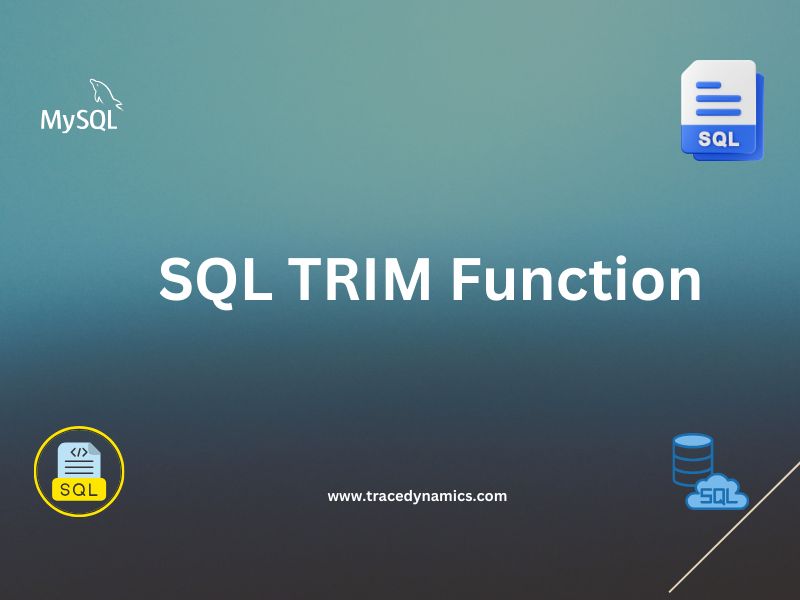SQL trim method: SQL, being a powerful language for managing data in databases, provides a variety of functions to manipulate strings, and among them, the SQL TRIM function holds a notable place. This function is crucial for cleaning up data and ensuring consistency across the database.
Key Takeaways
- The SQL TRIM function is essential for removing unwanted characters from strings, aiding in data consistency.
- Understanding and effectively utilizing TRIM, along with other similar functions like LTRIM and RTRIM, can significantly enhance data manipulation capabilities.
- Practical examples and common use cases further illustrate the importance and utility of the TRIM function in SQL.
Core Functionality of SQL TRIM
The SQL TRIM function is used to remove specified characters, or spaces by default, from the beginning (leading) and end (trailing) of a string. The basic syntax of the TRIM function is as follows:
TRIM ([characters FROM] string)
- Syntax and Parameters
- The
charactersis an optional parameter where you specify the characters to be removed. - The
stringis the input string from which the characters will be removed.
- The
- Removing Leading and Trailing Spaces
The most common use of the TRIM function is to remove leading and trailing spaces from a string. This is crucial for data consistency, especially when comparing strings or saving data to a database.
SELECT TRIM (' Hello World ') AS TrimmedString;
In the above example, the TRIM function will return ‘Hello World’ without the leading and trailing spaces.
Comparing SQL TRIM to Other Functions
The SQL language has other functions similar to TRIM, which also help in manipulating strings.- LTRIM and RTRIM Functions
The LTRIM (Left Trim) and RTRIM (Right Trim) functions are used to remove leading and trailing spaces respectively. While TRIM handles both sides of the string, LTRIM and RTRIM are used when the requirement is to remove spaces from only one side.
SELECT LTRIM(' Hello World') AS LeftTrimmedString;
SELECT RTRIM('Hello World ') AS RightTrimmedString;
Advanced Usage of SQL TRIM
The SQL TRIM function is not limited to just removing spaces; it can also be used to remove other specified characters from a string. This makes it a versatile tool for data cleaning and manipulation in SQL.
- Handling Special Characters
SELECT TRIM('x' FROM 'xxxHello Worldxxx') AS TrimmedString;
In this example, the TRIM function is used to remove the character ‘x’ from the beginning and end of the string.
- TRIM in Different SQL Dialects (Transact-SQL, PL/SQL, MySQL)
The implementation and usage of the TRIM function may slightly vary across different SQL dialects. For instance, the syntax for using TRIM in MySQL might be slightly different from that in Transact-SQL or PL/SQL.
Practical Examples
Practical examples provide a better understanding of how the TRIM function can be utilized in real-world scenarios.
- Removing Unwanted Characters from Data
In the above example, the TRIM function is used to remove the exclamation mark from the beginning and end of the string.
- Cleaning up Data using TRIM
Cleaning up data is crucial in database management to ensure consistency and accuracy of data. The TRIM function plays a significant role in this regard by removing unwanted characters from data.
Common Pitfalls and Best Practices
- Performance Considerations
It’s essential to consider the performance implications when using the
TRIMfunction, especially in large databases. Overuse or incorrect use ofTRIMcan lead to performance issues. - Common Mistakes to Avoid Some common mistakes include not specifying the characters to be removed when necessary, leading to unexpected results.
Frequently Asked Questions (FAQs)
What is the main purpose of the SQL TRIM function?
The main purpose of the SQL TRIM function is to remove specified characters, or by default spaces, from the beginning (leading) and end (trailing) of a string.
How does the SQL TRIM function compare to LTRIM and RTRIM?
SQL TRIM function can remove characters from both the beginning and end of a string, whereas LTRIM and RTRIM are used to remove spaces from the left and right of a string, respectively.
Can the TRIM function remove characters other than spaces?
Yes, the TRIM function can remove specified characters other than spaces from a string by providing the character(s) as an argument.
Is the syntax for TRIM the same across different SQL dialects?
The basic syntax is similar, but there might be slight variations across different SQL dialects like Transact-SQL, PL/SQL, or MySQL.
How can I use the TRIM function to improve data consistency in my database?
By using the TRIM function to remove unwanted characters or spaces from your data, you can ensure more consistent data entry and reduce potential errors in your database.
What are some common mistakes to avoid when using the TRIM function?
Common mistakes include not specifying the characters to be removed when necessary, and assuming TRIM will only remove spaces when other characters might also need to be addressed.
Can the TRIM function be used in conjunction with other SQL functions?
Yes, the TRIM function can be used alongside other SQL functions in a query to manipulate and format data as required.
What is the performance impact of using the TRIM function in a large database?
The performance impact can vary, but excessive or incorrect use of the TRIM function in a large database can potentially lead to performance issues.
Are there any alternatives to the TRIM function for removing spaces in SQL?
Yes, besides TRIM, functions like LTRIM and RTRIM, or even the REPLACE function can be used to remove spaces or replace characters in a string.
Can the TRIM function handle multiple characters for removal at once?
Yes, the TRIM function can handle multiple characters for removal if they are specified in the function argument.

